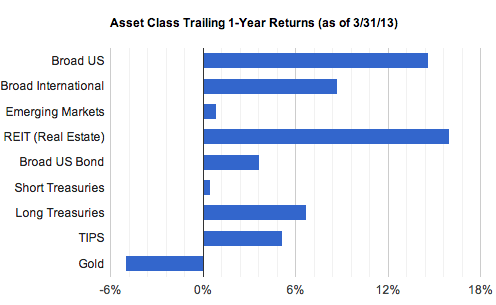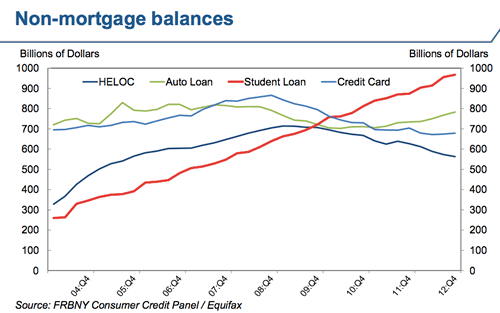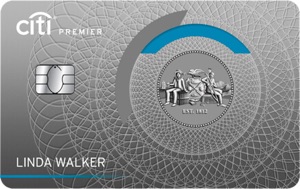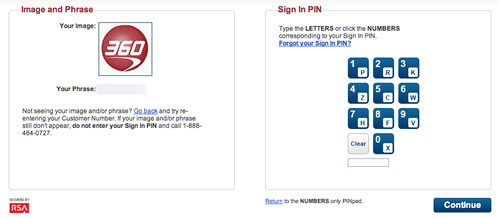Here is my April 2013 update of the trailing total returns for selected major asset classes. Passive ETFs are used to represent major asset classes, as they represent actual investments that folks can buy and sell. Return data was taken after market close at the end of March 2013.
| Asset Class Representative ETF Benchmark Index |
1-Mo | 1-Year | 5-Year | 10-Year |
| Broad US Stock Market Vanguard Total Stock Market (VTI) MSCI US Broad Market Index |
3.91% | 14.62% | 6.682% | 9.24% |
| Broad International Stock Market Vanguard Total International Stock (VXUS) MSCI All Country World ex USA Investable Market Index |
0.87% | 8.72% | -0.54% | 10.43% |
| Emerging Markets Vanguard Emerging Markets ETF (VWO) FTSE Emerging Index |
-1.56% | 1.69% | 0.90% | 16.44% |
| REIT (Real Estate) Vanguard REIT ETF (VNQ) MSCI US REIT Index |
2.90% | 15.97% | 7.37% | 12.36% |
| Broad US Bond Market Vanguard Total Bond Market ETF (BND) Barclays U.S. Aggregate Float Adj. Bond Index |
0.08% | 3.66% | 5.46% | 5.04% |
| US Treasury Bonds – Short-Term iShares 1-3 Year Treasury Bond ETF (SHY) Barclays U.S. 1-3 Year Treasury Bond Index |
0.00% | 0.48% | 1.61% | 2.56% |
| US Treasury Bonds – Long-Term iShares 20+ Year Treasury Bond ETF (TLT) Barclays U.S. 20+ Year Treasury Bond Index |
-0.31% | 6.70% | 8.28% | 7.43% |
| TIPS / Inflation-Linked Bonds iShares TIPS Bond ETF (TIP) Barclays U.S. TIPS Index |
0.22% | 5.17% | 5.80% | 6.45% (est.) |
| Gold SPDR Gold Shares (GLD) Price of Gold Bullion |
0.58% | -5.02% | 10.90% | 16.5% (est.) |
For an easy visual comparison, here is a chart of the 1-year trailing returns:

I collect this information because it allows me to keep an eye on the market while still keeping the long-term returns in perspective. Often, the asset classes with the best long-term returns have had recent poor performance. The 1-year chart helps me decide where to invest new funds and also for rebalancing. Note that I do not necessarily invest in all the listed asset classes, see my personal portfolio for details.
 Our family keeps a full year of expenses put aside in cash reserves; it provides us with financial stability with the additional side benefits of lower stress and less concern about stock market gyrations. Emergency funds can actually have a
Our family keeps a full year of expenses put aside in cash reserves; it provides us with financial stability with the additional side benefits of lower stress and less concern about stock market gyrations. Emergency funds can actually have a  Let’s focus on the Ally Bank certificates of deposit, where you can still access your money as long as you pay a early withdrawal penalty of 60 days interest – significantly less than at other banks. Why is this good?
Let’s focus on the Ally Bank certificates of deposit, where you can still access your money as long as you pay a early withdrawal penalty of 60 days interest – significantly less than at other banks. Why is this good?
 Many people enjoy the convenience of Amazon Prime, which for $79 a year gives you free 2-day shipping with no minimum purchase requirement, a decent streaming-video library, and a so-so Kindle book lending library. You may also know that you can share your shipping benefits with other people in your same household (with the ability to use multiple shipping addresses). At the same time, many people choose to get their stuff shipped to their workplace as one of those addresses. Amazon now explicitly allows you to share your shipping benefits with four other coworkers, which mean 5 coworkers can get free 2nd-day shipping by splitting $79 a year. See
Many people enjoy the convenience of Amazon Prime, which for $79 a year gives you free 2-day shipping with no minimum purchase requirement, a decent streaming-video library, and a so-so Kindle book lending library. You may also know that you can share your shipping benefits with other people in your same household (with the ability to use multiple shipping addresses). At the same time, many people choose to get their stuff shipped to their workplace as one of those addresses. Amazon now explicitly allows you to share your shipping benefits with four other coworkers, which mean 5 coworkers can get free 2nd-day shipping by splitting $79 a year. See  If you have a Citi credit card or a Citibank account from our partner Citi, with the ThankYou points rewards system, you have a wide array of options to redeem your points at
If you have a Citi credit card or a Citibank account from our partner Citi, with the ThankYou points rewards system, you have a wide array of options to redeem your points at 
 TaxACT Online
TaxACT Online  H&R Block at Home Online
H&R Block at Home Online  There was a lot of good discussion in my
There was a lot of good discussion in my  Fidelity recently announced new changes to their commission-free ETF list.
Fidelity recently announced new changes to their commission-free ETF list. Years ago I was contacted by an author named Gary Clayton who wanted permission to feature me in the next edition of his book. I said certainly, and pretty much forgot about it as it wasn’t published yet. The book was (is?) the bestselling high-school economics textbook in the country –
Years ago I was contacted by an author named Gary Clayton who wanted permission to feature me in the next edition of his book. I said certainly, and pretty much forgot about it as it wasn’t published yet. The book was (is?) the bestselling high-school economics textbook in the country – 
 The stock market is at or near all-time highs, which means that brokerage firms should be seeing a lot more interest (for better or worse). Weekly business newspaper Barron’s just released their
The stock market is at or near all-time highs, which means that brokerage firms should be seeing a lot more interest (for better or worse). Weekly business newspaper Barron’s just released their  Capital One bought ING Direct USA back in early 2012, and has finally completed their transition and re-branding. Their new savings account product is called Capital One Consumer Bank Savings. Since I’ve had an account with them for over a decade (September 2001, as they remind me every time I log in), here’s an updated review of my 2nd oldest bank account meant for both new and existing customers.
Capital One bought ING Direct USA back in early 2012, and has finally completed their transition and re-branding. Their new savings account product is called Capital One Consumer Bank Savings. Since I’ve had an account with them for over a decade (September 2001, as they remind me every time I log in), here’s an updated review of my 2nd oldest bank account meant for both new and existing customers.
 The Best Credit Card Bonus Offers – March 2024
The Best Credit Card Bonus Offers – March 2024 Big List of Free Stocks from Brokerage Apps
Big List of Free Stocks from Brokerage Apps Best Interest Rates on Cash - March 2024
Best Interest Rates on Cash - March 2024 Free Credit Scores x 3 + Free Credit Monitoring
Free Credit Scores x 3 + Free Credit Monitoring Best No Fee 0% APR Balance Transfer Offers
Best No Fee 0% APR Balance Transfer Offers Little-Known Cellular Data Plans That Can Save Big Money
Little-Known Cellular Data Plans That Can Save Big Money How To Haggle Your Cable or Direct TV Bill
How To Haggle Your Cable or Direct TV Bill Big List of Free Consumer Data Reports (Credit, Rent, Work)
Big List of Free Consumer Data Reports (Credit, Rent, Work)